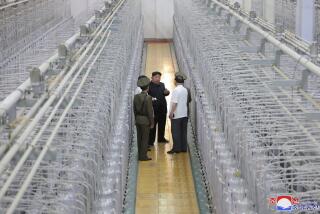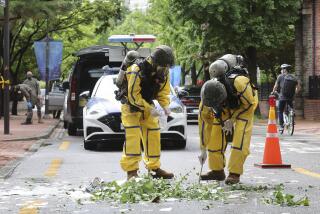N. Korean Leader Greets Visitor, China Report Says
PEKING â North Korean President Kim Il Sung greeted the visiting leader of Mongolia today at the Pyongyang airport, the official New China News Agency reported from the North Korean capital, ending a day of speculation that Kim was dead.
Rumors that Kim had died swirled through Asian capitals Monday after the South Korean Defense Ministry reported in Seoul that North Korean loudspeakers along the demilitarized zone separating the two Koreas had said Sunday that Kim had been shot to death.
The rumors were fueled by speculation of a power struggle in Pyongyang, perhaps pitting Kim against senior military leaders over such issues as the succession in the leadership of the isolated Communist country.
But much of the speculation ended with Kimâs reported appearance at the airport today to meet the Mongolian delegation headed by President Jambyn Batmonh. The delegation arrived from Ulan Bator, the Mongolian capital, by way of Vladivostok.
Many questions remained, however, including the veracity of the reported loudspeaker announcements across the demilitarized zone (DMZ). In fact, even as Kim was meeting his guests in Pyongyang, the South Korean Defense Ministry reported that loudspeakers at the DMZ were saying that the North Korean minister of defense, O Chin U, had seized power from Kim, Reuters news agency reported from Seoul.
Kimâs fate attracted worldwide interest partly because of the secretive nature of North Korea, a country closed to most outsiders, and partly because of his long hold on power in a country with a strong military sharing a divided peninsula with a bitter rival nation.
Kim, 74, who has ruled Communist North Korea since 1946 and transformed it into one of the most isolated nations in the world, did not appear in public Monday after the rumors blossomed, and diplomats in Tokyo, Peking and Seoul said they were waiting to see whether he showed up today to greet Batmonh.
They said that because President Batmonh is on a state visit he would ordinarily be received by Kim, the North Korean head of state.
Before Kimâs airport appearance, Pyongyang issued no statement to end the rumors about him. But North Korean diplomats in Peking, New Delhi and Moscow all denied the reports, as did other Pyongyang representatives, sometimes referring to todayâs visit.
âYou will see tomorrow,â a representative of the northâs party newspaper, Rodong Shinmun, told NHK, Japanâs semi-governmental radio and TV network, Monday night.
On the other hand, the Kyodo News Agency reported Monday from Hanoi that the Vietnamese Communist Party had received word from its North Korean counterpart that Kim had been killed. The Kyodo report quoted only an unnamed âreliable source.â
Grooms Son as Successor
Kim has been grooming his son, Kim Jong Il, 45, as his successor, in an effort to establish a political dynasty that would be unprecedented in the Communist world. Some North Korean military commanders are reportedly opposed to the sonâs succeeding Kim Il Sung, and this led to speculation that dissident military leaders had taken some action against the elder Kim in order to forestall an accession to power by the son.
After the Defense Ministry in Seoul reported the loudspeaker announcement of Kimâs death, South Korean Defense Minister Lee Ki Baek told the National Assembly on Monday that both U.S. military officials and the U.S. Central Intelligence Agency believed that the North Korean leader had, in fact, been killed.
But U.S. spokesmen in Seoul and Washington refused to comment on the South Korean assertions except to say that American troops guarding the area around the village of Panmunjom on the demilitarized zone between South and North Korea had not heard any broadcasts from North Korean loudspeakers saying that Kim had been killed.
Lee also told the National Assembly that the North Korean loudspeaker announcements had reported that Kimâs last words were: âThe Workersâ Party must not collapse. No matter what, the party must be maintained.â
âJudging from a series of indications from the north, either Kim is dead or there is a serious internal power struggle under way,â Lee said.
Could Be Psychological
He added, however, that the loudspeaker broadcasts might have been part of what he called âa highly sophisticated psychological operation against the south to cover up their (the northâs) war provocations.â
âUnder any circumstances, the government is fully ready to protect the peopleâs lives and assets,â he said.
Kim had made what appeared to be a hastily arranged trip to Moscow last month. The trip was scheduled only a few days after Secretary of Defense Caspar W. Weinberger announced in Peking that U.S. warships would make their first port call to China since the Communist takeover in 1949.
Analysts here said they believe Kim asked Soviet leader Mikhail S. Gorbachev for new weapons, including advanced fighter planes, but that they were unsure whether the Soviet Union had given the North Korean leader what he wanted.
One U.S. official in Peking theorized, before Kim appeared today, that North Korean military officers may have made an attempt on Kimâs life. âI think heâs been killed by the military,â this official said. âBut weâve got nothing solid yet. All the radio (in North Korea) is normal. On the other hand, Kim hasnât appeared, and thereâs no sign of him.â
U.S. officials who met with Chinese officials Monday were told that China had no information on the reports of Kimâs death.
Embarrassment Seen
Several diplomats said they could not imagine why South Korea would intentionally broadcast a false report that Kim had been shot. âAny way you look at it, it would be a major embarrassment for them if this turns out to be untrue,â one official said.
South Korean Defense Ministry spokesman Lee Heung Shik made the initial announcement of Kimâs death at 10:30 a.m. Monday without explaining why the ministry had withheld the information for one day.
He said only that, âon Nov. 16, 1986, the North Korean public address system along the demilitarized zone broadcast that Kim Il Sung, the North Korean ruler, was shot to death. However, the official news media of North Korea have not yet made any announcement or comment on the broadcast. The ROK (South Korean) armed forces are, as always, maintaining their state of readiness.â
The spokesman did not specify where along the 151-mile long demilitarized zone (which runs across the peninsula near the 38th Parallel) the North Korean loudspeakers had broadcast the reported announcement of Kimâs death.
The Hankuk Ilbo newspaper in Seoul, however, quoting South Korean police sources, said the loudspeaker broadcasts began in the western section of the demilitarized zone at 1:10 p.m. Sunday and had spread across the entire frontier by 2:40 a.m. Monday.
South Koreaâs Yonhap News Agency quoted unnamed security sources as saying the broadcasts came from six advance posts in the demilitarized zone.
For years, the North Korean loudspeakers have been a fixture along the unmilitarized zone, the boundary that divided Korea into a Communist north and a non-Communist south after the end of the bloody Korean War. Normally they are used to broadcast propaganda and martial music aimed at deoralizing South Korean soldiers.
Jim Mann reported from Peking, and Sam Jameson from Tokyo.
More to Read
Sign up for Essential California
The most important California stories and recommendations in your inbox every morning.
You may occasionally receive promotional content from the Los Angeles Times.










